SONAMARG TREK
Trek Itinerary
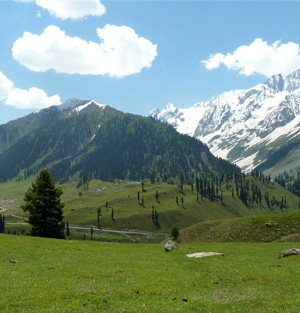
Arrive at Srinagar (on your own)
Murawah will arrange for the pick up from Srinagar TRC at 2 pm.
Drive from Sringar to Sonamarg, which is 4 hours away
The pickup is arranged in a Tata Sumo (or a similar vehicle)
If you are coming on your own to the campsite, you are expected to report to the Sonamarg base camp by 5 pm.

The trek to Nichnai covers a distance of 9 km.
3 km into the trek, you will spot a lone dhabha. Pick up your stock of short eats from here.
It is a total 3 hour ascent followed by 1 hour descent and finally a gentle 2 hour ascent to Nichnai which is at 11,500 feet.
The trail takes you through meadows, dense forests with Maple, Pine and Bhoj trees.
You will reach Nichnai in about 6 hours. Camp overnight at Nichnai.
Just before you reach Nichnai Pass you come across beautiful Lavenders.
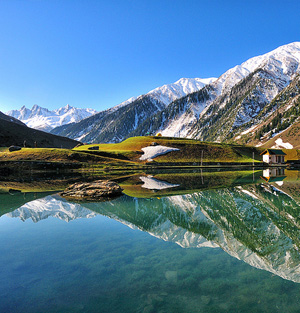
The days trek is a long 12 km walk on meadows with the scenery changing for the better all along.
Start by 8 am to give you enough time en route to enjoy the meadows.
Your first destination for the day is to cross the Nichnai pass or Vishnusar.
It will take you about 6 hours to reach Vishnusar, gaining an altitude of 2000 feet.
Pitch your tents next near a water source. Camp for the night.
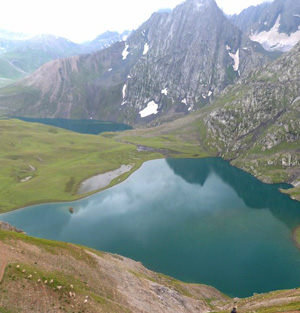
This day can be spent liesurely, exploring the twin lakes.
These lakes are full of trouts and trout fishing is popular. Obtain a permit from Srinagar for fishing.
The trail from Kishansar climbs up to the top of a ridge and on the top of the ridge is the Gadsar pass.
Spend time at the Kishansar meadows photographing the lake from various angles.
Camp for the night at Vishnusar.
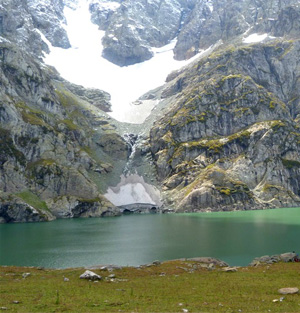
Start trekking towards the top of the ridge from Kishansar.
The trek is a steep 2 hour ascent followed by a steep descent followed a gentle walk in the meadows.
It will take you from 12,000 feet to the Gadsar pass at 13,750 feet covering a distance of 10km.
An hour into the trek, you will see the most beautiful view of the twin lakes together.
On the other side of the Gadsar pass stretches a long valley with 2-3 small lakes.
You can also see a few peaks outside the LOC (Line of control).
Walk through a long strech of multi coloured flowers, till you reach Gadsar lake.
You will reach the campsite in 5 hours.
There is an army camp closeby and all details of the trekkers and staff including original id cards are recorded, collected and checked here.
Camp for the night at Gadsar/near the army camp.
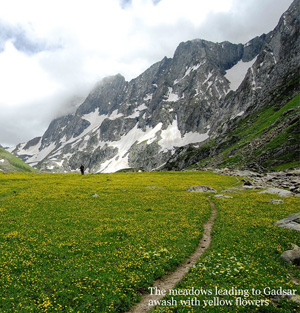
Begin your trek towards Satsar, traversing through meadows, a ridge and a stream.
The trek covers a distance of 12 km in 6 hours.
Before you reach the first lake, you will have to report to the Satsar army check post.
It is the 3rd line of defence from the LOC. The same process of ID checking, collection and questioning repeats here too.
Ten minutes out of the army camp is the first of the Satsar lakes.
The lake is pretty big and looks picturesque in its green setting with mountains in front.
Camp here for the night.
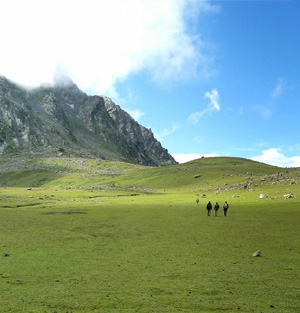
You will need to cover 9 km today. It may take around 6 hours.
The trail is mostly descending, with a few steep ascends, bringing you down from 12,000 feet to 11,500 feet.
Trek up half an hour out of camp, to reach the biggest Satsar lake.
The terrain is bouldery and it is more of a boulder hopping exercise than anything else.
Look out for the Gangabal and Nandkol twin lakes – a beautiful view from the top.
Descend further down to meadows and to the Nandakol lake, beside which is the Gangabal lake.
Camp for the night at Gangabal.
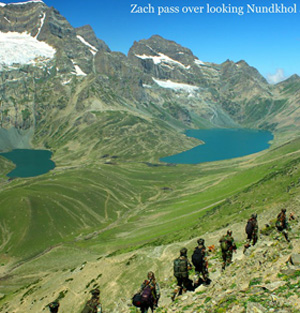
The final descent is quite taxing, as it involves a long and steep descent, but it also passes through the most beautiful pine forests.
It covers a distance of 11 km, and dropping from 11,500 feet to 7,45o feet.
The trail descends down a ridge onto a meadow with pretty little yellow flowers and then moves in and out of a pine forest until it hits the main road head of Narang.
You will reach Narang in about 6 hours. The tren ends at Naranag.
Naranag to Sringar
Murawah will arrange for the drop back to Sringar from Naranag.
The transportation cost is additional and will have to be paid directly to the driver.
You will reach Srinagar by 6:30 pm
Fitness Required
Minimum Age:14 years
Past experience in trekking:
Useful but not essential
You need to be in good physical condition before the start of the trek. You should be able to jog 4 kms in 30 minutes before commencement of the trekking expedition. The air is thin and the conditions difficult. You also need to carry a backpack that is heavy weight. Your physical fitness is important for a successful completion of the trek. Training yourself to get to a jogging distance of 4 km under 30 minutes makes your lungs strong and gives it ability to process less air for more work.
Flexibility is the ability of muscles and tendons to relax and stretch easily. It determines the amount of movement your bones can make in any direction around joints such as shoulders, elbows, hips and knees. Stretching improves your posture and helps to prevent low back pain. Stretching your hamstrings, quadriceps, hip flexors and low back muscles regularly, promotes relaxation in the tissues reducing the strain on your back. On your trek, it is important that you arrive on the slopes with your muscles relaxed. Carrying a backpack, however light, can become a strain after a while. These exercises will help you to be in good shape before the trek.
Going to Kashmir? Want to make sure you're fit enough to thoroughly enjoy the experience?
Things to get
Backpack (40-60 litres): Backpack with sturdy straps and supporting frame. Rain cover for backpack is essential.Daypack (20 litres): It is mandatory to carry a daypack if you choose to offload your backpack. If you decide to carry your backpack, day pack is not required.
Trekking shoes: No sports shoes. The shoes need to have soles with good grip and ankle support. Do not wear a new shoe to a trek. It might cause blisters. Before bringing them to trek, wear it for a week to make it softer. We recommend FORCLAZ 100, 500, and 600.
Socks (3 pairs): 2 cotton pairs, 2 woolen pairs (mostly to be used on campsites and while sleeping. Keep them dry.)
Trek pants (3 pairs including the one you are wearing): We highly endorse synthetic quick-dry pants as they are light. Plus, when it's cold you can wear one over the other. While trekking a pair is what you would carry apart from the worn. You could keep the third pair for your return journey.
Alternative : Cotton pant with many pockets / Track pants are comfortable too. Please do not get Denim jeans, shorts or 3 quarters to trek.
Collared t-shirts (3 pairs including the one you are wearing):Preferably light, full sleeve t-shirts. The collar and the sleeves prevent sun burns on the neck and arms. Avoid loud colors that would distract birds and animals.
Full sleeve woolens (2 pairs including the one you are wearing):We endorse fleece over wool as it is light weight, compact and warm.
Thick jacket: Carry 1 hollow full sleeve windproof jacket/down jacket
Thermal inners: 1 pair of lightweight, upper and lower (optional)
Raincoat/poncho: A lightweight poncho is preferred as it covers your rucksack as well from top. Raincoat can also be used as wind proof when required. Enquire Murawah for availability of ponchos at the base camp.
Balaclava: The cap must cover your ears and neck. You may also use scarves.
Synthetic handgloves: Ensure that the gloves are waterproof.
Suncap: 1 pair of nice warm gloves required, fleece or woolen. 1 pair of water proof/resistant, wind proof gloves. You get very thin inner gloves nowadays. You may get one of those to use layering.
Sunglasses: Curved ones will cover your eyes well. No blue coloured sunglass — they don’t block UV. Blacks, greens, browns are fine. Avoid multi tone sunglasses. Sunglasses prevent snow blindness. Sunglasses are mandatory for this trek.People who wear spectacles, choose one of these - contact lenses, photo chromatic glasses, or if either of the above is not possible, wear your spectacles and carry a big sunglass that can be worn over your spectacles.
Toiletries (Sunscreen - SPF 40+, moisturiser, light towel, lipbalm/chap stick, small soap, toilet paper, wet tissue)
Repair kit (needle & thread)
Headlamp/LED torch: Mandatory
Camera: Carry all accessories - spare batteries, charger, etc.
Cutlery: Carry a plate, spoon, coffee mug & a lunch box. We insist on trekkers getting their own cutlery for hygiene reasons. To save weight, you may use your lunch box to have food in it and also carry it.
Water bottles: 2 bottles, 1 Litre each. Packaged drinking water bottles like Aquafina, Bisleri and others are not allowed.
Trekking pole: Trekking pole is mandatory. Duralumin 4-step telescopic anti-shock trekking poles are available with Murawah at the cost of Rs 450. To order mail us at support@murawah.com
Plastic covers: While packing, use plastic bags to compartmentalize things and carry few extra plastic bags for wet clothes.
Diamox - 10 tablets (to prevent AMS)
Crocin – 6 tablets (fever)
Avomine – 4 tablets (motion sickness)
Avil 25mg – 4 tablets (allergies)
Combiflam – 4 tablets (Pain killer)
Disprin – 6 tablets (headache)
Norflox TZ & Lomofen– 6 tablets each (diarrhea)
Digene - 10 tablets (acidity)
Omez/ Rantadine – 10 tablets (antacids)
Crepe bandage – 3 to 5 meters
Gauze - 1 small roll
Band aid – 10 strips
Cotton – 1 small roll
ORS – 10 packets
Betadine or any antiseptic cream
Moov spray (aches, & sprains)
In addition, please carry the below three documents. Document two and three need to be downloaded (PDF), filled in, signed and handed over to the trek leader at the base camp. Without these documents you will not be allowed on the trek.
1. Original and photocopy of government photo identity card- (driving license, voters ID, etc.)
2. Medical Certificate, and disclaimer (to be filled by the trekker)
3. Medical certificate (to be filled by a doctor)
How to get there
Its suggested to arrive at Srinagar a day prior to the trek as it helps in acclimatization.
Depart from Srinagar TRC by 2 pm and drive to Sonamarg base camp (4 hrs).
This transport arrangement will be co-ordinated by Murawah.
Cost of transport is to be shared among trekkers abd paid directly to the driver. Approx. cost Rs. 2200 one way.
If you are coming on your own to the campsite, you are expected to report to the campsite by 5PM.
The trek starts from Shitkadi, it’s 4 kms before Sonmarg while coming from Srinagar.
The trek starts from Shitkadi, it’s 4 kms before Sonmarg while coming from Srinagar.
You are expected to report to the campsite by 5PM.
Reserved vehicles:
If you plan to travel on your own with a group size of 5 – 7 members, you may chose to reserve a vehicle. Vehicles like Travera, Innova, Travellers, Sumo, Scorpio are available on demand.
Shared Vehicles:
From Jammu, shared vehicles are available from - Vikram Chowk, Railway Station
From Srinagar, shared vehicles are available from Karanagar, to Kangan, to Sonamarg
Map
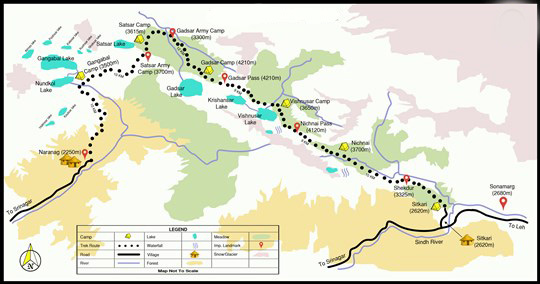
Trek Fee
SONAMARG TREK
Rs 12,500
per person (Includes all costs of the trek from
Sonamarg to Naranag)
Note: Service tax at 3.63% is payable on the trek fee
Contact Us
Registered Trekkers call:
9469772952
Mon-Fri: 9.30 AM – 7.00 PM
Sat: 9:30 AM – 1:00 PM
write to us at: reservation@Murawah.com
Trek Itinerary
Day 1: Arrive at Srinagar. Depart Srinagar by 2 pm and drive to Sonamarg base camp (4 hrs).
Day 2: Sonamarg to Nichani via Shekdur
Day 3: Nichnai to Vishnusar lake
Day 4: Explore Vishnusar and Kishansar twin lakes.
Day 5: Vishnusar lake to Gadsar lake via Kishansar lake
Day 6: Gadsar lake to Satsar lake
Day 7: Satsar lake to Gangabal twin lakes
Day 8: Gangabal lake to Naranag. Drive to Srinagar and reach by 6.30 pm. Stay overnight at Srinagar.
Trek Info
| Difficulty | Medium difficult. The trek is long with several steep ascents and descents. Generally snow free. |
| Trail Type | A cross over trail through meadows and several passes. |
| Road head | Sonamarg in Jammu and Kashmir. Srinagar is the nearest airport. |
| Base Camp | Sonmarg |
| Best Season | End of June to end of September. It is a meadow trek hence best done with the grass is green and flowers are in bloom. |
